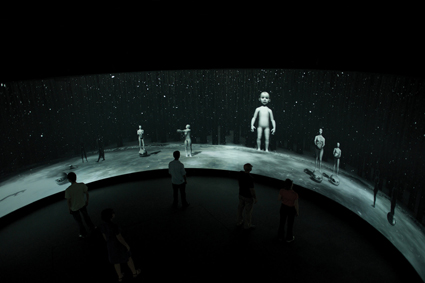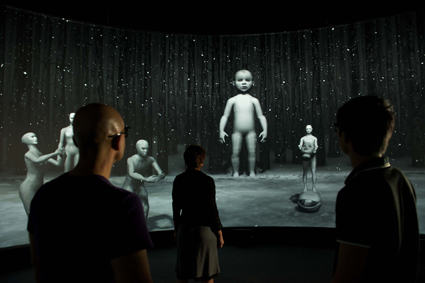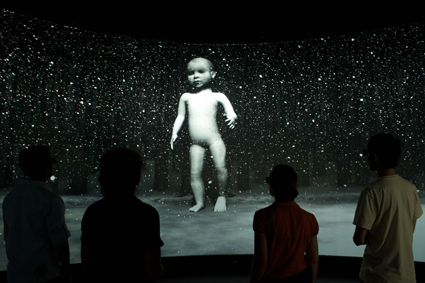a dark 21st century folktale
james paull: edward scheer on dennis del favero's scenario

Scenario
photo courtesy of iCinema
Scenario
SCENARIO, DIRECTED BY THE ARTIST DENNIS DEL FAVERO, IS A 360-DEGREE, 3D INTERACTIVE CINEMATIC STORY, THE RESULT OF AN EXTENSIVE COLLABORATIVE PROJECT AT THE UNIVERSITY OF NEW SOUTH WALES. IT PREMIERED AT THE 2011 SYDNEY FILM FESTIVAL ATTRACTING MEDIA ATTENTION BOTH FOR ITS CINEMATIC INNOVATION AND EERIE ATMOSPHERICS.
Edward Scheer, who teaches at the Faculty of English, Media and Performing Arts at UNSW, has followed the evolution of the project and written a companion study. I spoke with Scheer, who believes that Scenario marks a new level of interdisciplinary research in innovative technology. Its more profound value, however, is as a poetic text that taps into archetypal human experience.
an eye as avatar
Scenario opens with a shadowy underworld that beckons the audience to enter and engage with its humanoid inhabitants. In Scheer’s words: “You walk into a 360-degree environment and you see some eyes staring at you. A voice tells you to choose an eye and the eye becomes your avatar. Then a humanoid figure jumps on top of the eye and leads you through a series of underground spaces—spaces of abandonment, one suspects of criminality. You are told that you have to find the body parts of a humanoid child and that these parts have to be returned to the child. One is therefore introduced to a scene of horror but in a gentle way. You are also implicated in the restitution of this violent act.”
The fact that the spectator is not just a voyeur immediately suggests an unusual cinematic experience. Scheer observes that in conventional cinema one is passive in a “cinematic machine that grinds on regardless of your subjective investment.” In contrast, this work opens an interesting ethical space. Scenario has a tracking device which picks up the spectator’s motion. Ultimately, if the body parts are successfully returned to the child, the child is free to walk away. However, if the parts are not returned, an apocalypse descends, ash falls from the sky and there’s a blackout. There are two endings then, each contingent on the active spectator’s participation.
Scheer believes that the unique way Scenario brings together interactive narrative, aesthetics and the use of 3D makes it a world first, one situated within the broader achievements of iCinema itself: an ARC-funded project to look at new software, screening environments, narrative possibilities and spectatorship experiences. The research centre has created the 360-degree Advanced Visualisation and Interaction Environment (AVIE), unique in itself. Over the last ten years some quite remarkable works of new media interactive art, such as Eavesdrop (2004) and There is still time…Brother (2007), have been produced there pushing the boundaries of disciplines and separations between art practices.

Scenario
photo courtesy of iCinema
Scenario
performative media
The question of whether Scenario’s immersive environment fits comfortably within a film festival program leads Scheer to ponder if cinema is actually the right model for such an experimental and interdisciplinary approach. “The cinema-goer is not going to have the same kind of experience that they will be used to. Theatre-goers might be more familiar with the kinds of calling forth of one’s own subjective experience to respond to the material.”
Where then should Scenario be positioned? Scheer calls it “performative media” as it is setting up a mediated space. The humanoid behaviours are modelled on live actors—achieved through the use of motion capture to establish a library of behaviours. There is also the way the spectators have been animated through their involvement in the media. This genealogy resembles media art and crossover performance art. While such a genre reminds cinema of its own performative roots, it remains uncertain if it will have commercial possibilities in the cinema. It has in other fields—the iCinema project has been taken up, for example, by Chinese mining industries.
collaboration as research trajectory
Scheer became involved in the Scenario project several years ago when Dennis Del Favero talked about it in the context of their mutual admiration of the work of Samuel Beckett. “When Dennis told me that Scenario was based on Beckett’s Quadrat, I started turning up to the early iterations of the work.” After giving some feedback, Scheer was formally invited to be the official scribe. It has been a two-year project working with the team with an eye to reporting on compositional and dramaturgical processes, examining its precursors and providing a reading of the work as Scheer sees it.
Scheer describes the collaboration as “a kind of open source dramaturgical project.” The computer scientists rendered the images with Dennis Del Favero. The playwright and screenwriter Stephen Sewell provided the text which changed as the project evolved. Visual designers gave cues to the visual world as it was being formed. These people were sharing their ideas with the computer scientists. “It was a fascinating set of exchanges with Dennis directing but doing so with tremendous generosity. The depth and complexity evolved through these discussions, properly interdisciplinary.”
If the scale of this interdisciplinary collaborative process suggests a new trajectory in the creative research process in the arts, Scheer would point to new media art as a leader simply because of the increasing scope of digital systems requiring a multiplicity of skills to create a meaningful experience for audiences. However, he suspects that a similar modality of collaboration is influencing the way academics engage with artists who traditionally have worked very much alone with their own imagination. Scheer cites his own research on Mike Parr, with whom he has long been in conversation in order to make the artist’s output available to a wider audience. Perhaps it is not just that artworks are changing but the way the academy is engaging with artists. Instead of sitting back and making critical judgements about the value of an art work, academics are now talking with artists, trying the develop a conversation around the work and from that process the reading emerges.
the limits of representation
In his attraction to Scenario Scheer was mindful of the work of Antonin Artaud on whom he wrote his PhD and still someone he considers a massively inspirational force in contemporary aesthetics. “Artaud worked in all of the media of his time and was acutely aware of the confluence of creative forms across different media and the performative, transformative power latent within them.” He believes that Del Favero is clearly engaged in a similar aesthetic, trying to break through to very essential experiences such as trauma, which cannot be encoded within representational media. That which eludes representation was the concern of the “theatre of cruelty.” “What other forms are available that can pursue experiences otherwise fundamentally lost?”
a folktale
Underlying the experience of trauma is something perhaps even more elemental, namely the experience of confinement. I ask Scheer if Scenario stands as a 21st century folktale about the urge to find freedom from one’s received confines. He believes so as it picks up on those universal experiences of loss and abandonment as well as the sense of containment and release. Scenario’s intertext is the Josef Fritzl case, which provides an elusive subtext to some of the work’s narrative. “This was an experience of depravity but also one of containment —seven children confined for 24 years in a cellar beneath the house in Amstetten in Austria. Imagine waiting for 24 years to be released.” Scenario not only tracks the endless experience of confinement but in a form that takes the shape of a folktale.
Scheer considers the tale an ur-story by which he means that the drama is not something happening for the first time; rather, we have seen it all before. He is not alone in thinking this way. Elfriede Jelinek, Austria’s Nobel Prize winning writer sees the Fritzl case as a typical performance of Austria, something that requires no rehearsal because male violence against women is an everyday performance. Scenario taps into that story, “not as something to fetishise but as an archetypal experience that leaks out of the four walls of the basement in Amstetten to be picked up here, perhaps ultimately as an atmosphere of threat, menace, loss and possible recuperation.”

Scenario
photo courtesy of iCinema
Scenario
containment & release
Such an atmosphere is played out as a spatial dialectic, akin to Gaston Bachelard’s “poetics of space.” The spectator experiences the phenomenology of restriction and containment: corridors, tunnels, basements, cracks in the ceiling through which you see the rain coming down, an inner city alleyway. The final scene reveals a frozen lake in a forest and there is a more expansive sense of space. In one version this space closes down. In the ‘happy ending’ version, it opens out and the gigantic figure of the child rediscovers its motility, moving out of the space of confinement towards the space of the forest. “The phenomenology of this for the spectator is very evident in that we experience expansiveness as opposed to restriction, freedom not isolation. Seeing this giant figure moving gives us a sense of hope.” This is important to a reading of so dark a work. At least in one version, the work is ultimately quite hopeful in tracking the relations between self and other.
Edward Scheer Scenario (2011), UNSW/ZKM Press, www.unswpress.com.au; Scenario, director Dennis Del Favero, writer Stephen Sewell; other credits at: www.icinema.unsw.edu.au
This article originally appeared in our July 26 e-dition.
RealTime issue #104 Aug-Sept 2011 pg. web






